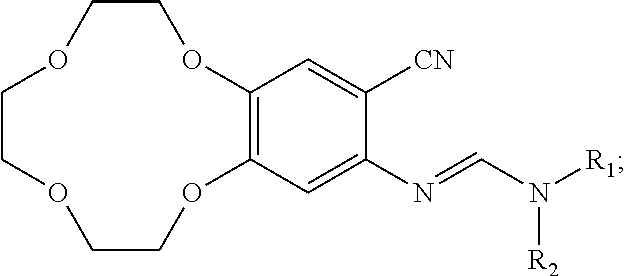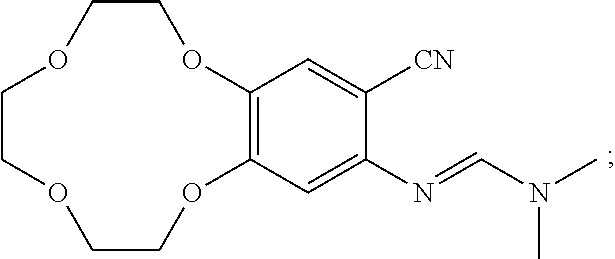Methods of preparing icotinib and icotinib hydrochloride, and intermediates thereof
- Summary
- Abstract
- Description
- Claims
- Application Information
AI Technical Summary
Benefits of technology
Problems solved by technology
Method used
Image
Examples
example 1
Synthesis of Compound A
1. Synthesis of Compound 2
[0074]
[0075]3,4-dihydroxyphenyl nitrile (79.5 g), potassium carbonate (272 g), and acetonitrile (6 L) were added into the 10 L of three-necked reaction flask. The reaction mixture was stirred to dissolve and heated to reflux. Then acetonitrile solution of compound 1 (compound 1, 200 g; acetonitrile, 2 L) was dropwise added under reflux condition. After its completion by HPLC monitoring, the reaction mixture was cooled to room temperature, filtered to remove the solvent. The resulting solid was dissolved in ethyl acetate and filtered. The filtrate was concentrated, and the remainder was dissolved in petroleum ether and evaporated. The residue was purified to give compound 2 (18.9 g).
[0076]1HNMR (CDCl3-δ ppm): 7.30˜7.33 (m, 1H); 7.25 (s, 1H); 6.97-6.99 (d, 1H); 4.19˜4.23 (m, 4H); 3.83˜3.91 (m, 4H); 3.77 (s, 4H).
[0077]MS: (M+H)+250
2. Synthesis of Compound A
[0078]
[0079]Compound 2 (41.6 g) was dissolved in acetic acid (580 mL) and heated t...
example 2
Synthesis of Compound B
[0081]
[0082]Compound A (32 g), ferrous powder (30.5 g), 5% acetic acid in methanol solution (1070 mL) were added into 2 L of reaction flask and heated to reflux. The reaction mixture was cooled and concentrated after the reaction was complete by TLC monitoring. The concentrated reaction solution was dissolved in ethyl acetate, filtrated and dried by anhydrous sodium sulfate (Na2SO4), the solvent was removed to give compound B (23 g).
[0083]1HNMR (d6-DMSO-δ ppm): 7.07 (s, 1H); 6.36 (s, 1H); 5.73 (s, 2H); 3.95˜4.22 (m, 4H); 3.77˜3.78(m, 2H); 3.34˜3.62 (m, 6H).
example 3
Synthesis of Compound C1
[0084]
[0085]Compound B (5 g), N,N-dimethylformamide dimethyl acetal (5 g), and dioxane (160 mL) were added into 500 mL of three-necked flask, heated to reflux, and the reaction was monitored by TLC. The mixture was reacted for 12 hours. After its completion, the reaction solution was cooled to room temperature and evaporated to give compound C1 (5.8 g).
[0086]1HNMR (CDCl3-δ ppm): 7.56 (s, 1H); 7.15 (s, 1H); 6.51 (s, 1H); 4.12˜4.18 (m, 4H); 3.89˜3.91 (m, 2H); 3.78˜3.80 (m, 6H); 3.07 (s, 6H)
PUM
 Login to View More
Login to View More Abstract
Description
Claims
Application Information
 Login to View More
Login to View More - R&D
- Intellectual Property
- Life Sciences
- Materials
- Tech Scout
- Unparalleled Data Quality
- Higher Quality Content
- 60% Fewer Hallucinations
Browse by: Latest US Patents, China's latest patents, Technical Efficacy Thesaurus, Application Domain, Technology Topic, Popular Technical Reports.
© 2025 PatSnap. All rights reserved.Legal|Privacy policy|Modern Slavery Act Transparency Statement|Sitemap|About US| Contact US: help@patsnap.com



